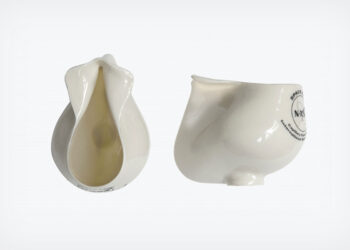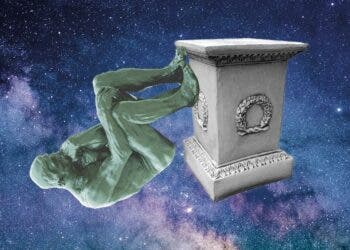Would you trust a wasabi-scented fire alarm to save your life? How about a scientific test for infidelity that smells your partner’s underwear? Or a high-speed camera used to study the flight dynamics of falling cheese? These sound like the inventions of a mad scientist (and maybe they are), but they all teach us something about the world.
Each of these wonderfully absurd creations earned an Ig Nobel Prize, a parody of the Nobel Prize awarded annually for research that “first makes people laugh, then think.” And while they may seem like the world’s most useless inventions, they reveal something powerful about how science works: curiosity, no matter how ridiculous it seems, often leads us to unexpected truths.
A Fire Alarm That Smells Like Wasabi

In 2011, Japanese researchers Mayu Yamamoto and Makoto Imai developed a fire alarm for people with hearing loss. You may expect the alarm to trigger a visual alert or something, but instead, it sprayed wasabi gas.
Yes, the same chemical that gives sushi its sinus-burning kick (allyl isothiocyanate) was repurposed into an olfactory emergency system. When tested, the alarm woke sleeping people within seconds—even from deep sleep. It wasn’t just a clever gimmick; the wasabi alarm received a patent and was later tested in real care home environments.
This “useless” invention highlights the power of sensory substitution—replacing sound with smell to convey urgent information. It may one day save lives, especially in hospitals or homes for the elderly. The team was awarded the Ig Nobel prize for “determining the ideal density of airborne wasabi (pungent horseradish) to awaken sleeping people in case of a fire or other emergency, and for applying this knowledge to invent the wasabi alarm.”
The Toast Drop Machine
What happens when you drop a piece of buttered toast? As folk wisdom and Murphy’s Law would have it, it always falls on the buttered side, causing maximum problems. But is that really the case? In 1996 Robert Matthews of Aston University in the UK set to investigate.
Matthews study revealed that the phenomenon is rooted in basic physics—specifically, the limited height of a typical table doesn’t allow the toast enough time to complete a full rotation once it starts falling. His calculations suggest that what seems like Murphy’s Law in action is actually a predictable outcome of angular momentum and gravitational pull.
This deliciously silly study was put into practice on a segment of the show Mythbusters, where they actually built a toast dropping machine, confirming the theory.
The Bra That Turns Into a Gas Mask

Elena Bodnar, a Ukrainian researcher, invented a bra that could quickly convert into two gas masks—one for the wearer and another for a nearby companion. Inspired by the Chernobyl disaster, the device even included straps for securing it over the face.
The design, while humorous, highlights the importance of rapid-response personal protection, especially in disaster zones. The concept was even patented in the U.S. though as far as we can tell, it never really became mainstream.
The Mosquito Cheese Trap
Scientists discovered that malaria-carrying mosquitoes are attracted to Limburger cheese, because it emits compounds similar to human foot odor. Bart Knols of Wageningen Agricultural University and colleagues were awarded the Ig Nobel Prize in 2006, but this was just a start.
Several other studies, including a 2020 one, found that various cheeses—particularly Brie, Raclette, and Limburger—emit microbe-derived odors that strongly attract mosquitoes looking for hosts or places to lay eggs. When mosquitoes choose to lay their eggs in cheese infusions, the very same microbial environment that lured them in ends up killing their larvae—creating what scientists call an “ecological trap.” Surprisingly, the traps also drown spotted wing Drosophila, an invasive fruit fly pest.
While it might sound like a laughable misuse of charcuterie, the research opens a door to low-cost, sustainable pest control using fermented dairy products as “attract-and-kill” tools. What began as a curiosity about Limburger cheese’s foot-like smell has evolved into a microbial strategy for tackling two global insect nuisances—suggesting that even the stinkiest ideas might just make the world a little healthier.
Tearless Onions

In 2013, Japanese chemists isolated the exact enzyme responsible for making us cry when we chop onions: lachrymatory-factor synthase. They showed that the mechanisms through which onions make us cry are even more complex than we thought, but using genetic engineering, they created onions that didn’t trigger the same tearful response.
But this was just the start.
For over a decade, they perfected their method. They made better and better onions that didn’t make you cry, and currently, you can find “tearless onions” in several countries. The commercially available ones were not GMO’d directly but rather controlled through selective breeding.
A Method to Extract Vanilla From Cow Dung
In 2007, researcher Mayu Yamamoto (yes, again) won an Ig Nobel for discovering a way to extract vanilla flavoring from cow dung. Using sophisticated chemical extraction methods, she isolated vanillin molecules from bovine feces. She claimed it could become a sustainable alternative to traditional vanilla, which is in short supply.
Why it matters: While the idea of “poop vanilla” makes most people gag, the technique could be adapted to extract valuable compounds from organic waste—a concept now common in sustainable biochemistry and waste valorization.
A DIY colonoscopy
Most people wouldn’t dream of performing their own medical procedures, but Japanese physician Akira Horiuchi dared to ask: What if you could do your own colonoscopy? In a 2006 study titled “Colonoscopy in the Sitting Position: Lessons Learned from Self-Colonoscopy”, Horiuchi demonstrated exactly that—by performing a self-colonoscopy in a hospital chair, using a standard pediatric colonoscope.
Armed with only local anesthesia and a lot of determination, Dr. Horiuchi inserted the scope himself, reporting minimal discomfort and excellent visualization. He later won the 2018 Ig Nobel Prize in Medical Education for this unorthodox feat.
While the concept sounds outrageous, Horiuchi’s goal was to reduce embarrassment and increase screening rates in Japan, where colon cancer is often underdiagnosed. His study sparked conversation about patient-centered care and demystifying medical procedures—showing that even the most cringe-inducing ideas can push healthcare forward in unexpected ways.
The Quirkier Side of Science
Many of these inventions seem to border on satire. But they’re not jokes. They’re science in its most playful, subversive, and surprisingly insightful form.
These studies reveal overlooked truths, highlight gaps in our assumptions, or explore serious challenges through humor. They reflect the spirit of scientific inquiry at its most human: driven not just by funding or fame, but by an irrepressible itch to ask, “What if?”
As Isaac Asimov once said:
“The most exciting phrase to hear in science, the one that heralds new discoveries, is not ‘Eureka!’ but ‘That’s funny…’”






